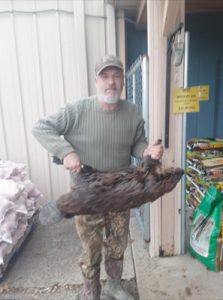Local man shares of damage and destruction Beavers can do to property.
Cover photo by Niklas Hamann.
Story and featured photo’s by Steve Linenfelser
Ever since I was a kid I have been fascinated by wildlife. I remember watching this special about the American beaver. It’s North America’s largest rodent and there are many fun facts about beavers that I learned over the years.
For example, did you know that they have orange teeth? Their teeth are not orange because they have bad hygiene, but because their teeth contain iron. The iron in their teeth makes them strong, and the orange enamel on the front of their teeth wears away more slowly than the white dentin on the back, which helps their teeth to self-sharpen as they chew on trees.
They are suited for going underwater as their ear and nose valves shut when going underwater, they have a third eyelid that acts as goggles and their lips close behind their teeth, allowing them to carry branches underwater without drowning.
However, probably the most fascinating fact about them is a chemical compound called castoreum which comes from the beaver’s castor sac which is located under its tail. This compound has the consistency of honey but smells like musky vanilla and is actually an FDA-approved natural flavoring for vanilla. Beaver vanilla ice cream anyone?
It was because of the beaver that early colonists came to America to trap them for their valuable fur and settled here permanently. Beavers are beneficial in nature because their dams create habitat for many species of wildlife. Yet, sometimes when beavers come in contact with people, they can cause problems.
Recently while stopping at Knutson’s Sporting Goods store here in Brooklyn I came across a gentleman named Tom Biddix from Addison. He was showing one of the Knutson employees a critter that he had recently trapped and was having it weighed.
Tom Biddix of Addison is pictured in front of Knutson’s Sporting Goods in Brooklyn. Biddix caught this 42-pound beaver near Devils Lake. It had caused damage to more than 100 trees.
When I walked up to the front door there was Tom, holding up a forty-two-pound beaver that he had trapped as it had been causing many problems for a family by Devils Lake. I asked him if I could take his picture and chatted with him about this beaver and how he came about trapping it.
Tom has been a lifelong trapper, but over the last two years, he started trapping beavers to help people who had problems with them. I asked Tom if the forty-pound beaver was the heaviest he had heard of and he explained that there was one that he knew had weighed seventy pounds! The individual’s property where Tom trapped the beaver had chewed and killed over one hundred trees.
He stated many of the trees were several inches in diameter which mean that they could be ten to fifteen years old. During the summer I had a couple that called the Exponent and wanted to know what to do about a beaver that had damaged their boathouse. Beavers have one to four babies or kits as they are called, and the babies will stay with the parents for two years until they move on to build a lodge and dam of their own. During this time, the beavers not only damage trees, but their dams can cause flooding. I have personally experienced this along with my friend Jim as he, his son, and I made a trip up to Canada to go walleye fishing several years ago.
When we arrived at the area where we were going to access this one particular lake, we drove Jim’s Jeep along a two-track until we were met with several inches of water that was caused by a beaver dam. This dam wasn’t there three years earlier when Jim had been fishing before, so we weren’t prepared for it.
We had to climb over the dam and transport our kayaks and gear over it. While doing this I pulled a groin muscle, which is not fun, especially when we had to paddle several hundred yards in order to get to an island destination in the middle of the lake. I was in a lot of pain and the concern was if I capsized in the frigid water hypothermia could set in. Although I was uncomfortable, it was the trip back that caused the real problem. When we reached Jim’s Jeep, we noticed that the water level over the two-track had risen significantly. We drove through and when the water got up to the windows, the Jeep suddenly stalled out.
Jim tried in vain to restart the Jeep, but we knew the engine was dead. Now we were faced with a real problem. We had no cell signal, it was getting dark, the temperature was dropping rapidly (it was September), and we had noticed several wolf and bear tracks. After making it to the road, which was over twenty miles to the nearest town.
Finally, a Canadian couple after spotting Jim’s fifteen-year-old son with a scared look on his face stopped and gave us a ride. We made it to a motel that was owned by a couple from Michigan. The next day they helped Jim tow out his Jeep to the road. While relieved, we now had to get back to Michigan and also had to get Jim’s Jeep back. The cost of renting a vehicle and a new engine cost Jim a whopping $7,500, not to mention two twenty-hour trips to get his Jeep back.
Now to be fair, we were in the beaver’s territory and the beaver was doing what beavers do. However, they not only can be a nuisance in the Canadian wilderness but also at our nation’s capital. In 1912 Japan had donated several cherry trees to the United States, but in April of 1999, right when the cherry trees had blossomed, there was a call to authorities near a national park about how “someone had chopped down a cherry tree.” It turned out it was a beaver that chewed through four cherry trees and five white cedar trees.
Since beavers rarely venture out during the day, no one had witnessed the beavers in the act of chewing on cherry trees, some being over one hundred years old. Yes, beavers are beneficial to nature, but they can cause problems when there are too many of them or they get too close to people. That’s why since wolves and cougars no longer keep them in check here in southern Michigan the only natural predator left is the coyote. And that’s why trapping helps to keep their numbers down. In September of last year, a 73-year-old Massachusetts man was mauled while swimming by a rabid beaver. Rabies can spread fast, so wildlife management helps everyone, including the beavers. So let’s admire and respect nature’s engineers but watch out for its teeth. And, as my friend Jim would say, those damn dams.






We send a transaction from us. GЕТ >>> https://telegra.ph/Get-BTC-right-now-01-22?hs=311d30981e46fc6134c17884a1b45718&
January 24, 2025 at 12:31 pm
uenjqm